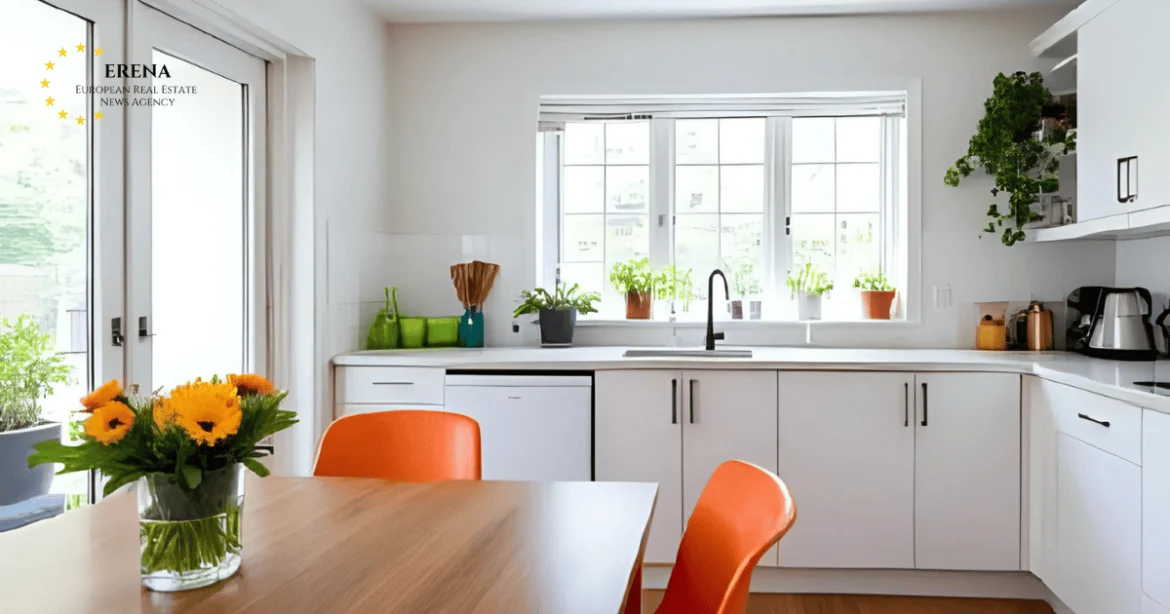In 2025, buyers across Europe are more selective. Higher mortgage costs, stricter energy rules, and living-cost pressure mean people want stylish, efficient, move-in-ready homes. The good news: you do not need a five-figure budget. Small, targeted upgrades can lift perceived quality, cut time on market, and, in many cases, push the final sale price. In the UK, for example, A–B rated homes sell for a modest 1.7% premium versus D, while F–G homes trade at a 3.5% discount—margins that matter in a slower market. Rightmove’s Greener Homes analysis shows a rising share of properties achieving EPC C or above, and energy-savvy listings attract more attention. “Some of the easy gains have already been made … it is going to get increasingly difficult,” says Tim Bannister, Rightmove’s Director of Property Science—another reason to focus on the best-value upgrades.
Fresh paint with real prep
A professional repaint remains the strongest value play. Typical interior prices in 2025 run €20–€65 per m² depending on region and prep. A mid-size 20 m² room often lands around €360–€1,300 including standard materials. Prioritise filling and sanding, stain blocking, and resealing corners; warm whites and soft neutrals read larger and cleaner in photos.
Modern lighting and switch plates
LEDs are a quick win: swapping remaining halogens to LED can save roughly ≈€50 per year in a typical British-tariff scenario, with similar directionally positive savings across Europe. Fresh faceplates and switches are inexpensive—mainstream ranges often retail €10–€30 per unit—and an electrician typically charges ≈€120–€230 per point depending on access. The crisp look in listing photos is worth it.
Kitchen refresh instead of replacement
You can modernise a tired kitchen without a full rip-out.
- Laminate worktops from about €35–€58 per metre
- Mixer taps commonly €23–€175
- New handles €15–€40 per pair
Doors stay, layout stays—yet the space photographs like new and feels move-in ready.
Bathroom touch-ups that sell
Full refits often cost €7,600–€15,200, and sellers rarely recover that outlay on a quick sale. Cosmetic upgrades do: regrouting ~€18 per m², fresh silicone, and a mid-range mixer (€70–€170) erase wear and boost buyer confidence on hygiene. Add a new shower head and a bright, mould-resistant paint for a clean, hotel-style finish.
Sand and revive timber floors
Uniform floors elevate the whole flat. Typical sanding and sealing ranges €25–€64 per m² across the EU and can be completed quickly in a standard room. A low-sheen, mid-tone finish photographs well, hides minor defects, and ties rooms together so spaces feel larger and more expensive.
Front door and curb appeal
If the door is sound, prep and paint plus upgraded numbers and hardware can achieve most of the visual impact at minimal cost. For replacements, 2025 guides show installed front doors from about €1,050 to €5,200 depending on material and complexity. Clean lighting at the entry and a tidy threshold frame the viewing before the first step inside.
Insulation and draught-proofing
Receipts for energy upgrades now matter. Loft insulation remains the cheapest EPC lift: mineral wool frequently works out around €6–€13 per m² for materials, with modest labour on top. Draught-proof letterboxes, keyholes, and sash gaps; simple measures can save ≈€100 per year (more with an open-chimney blocker). The paperwork helps justify the rating and reassures first-time buyers about running costs.
Double glazing where it counts
Upgrading single glazing to modern double glazing can save about ≈€170 per year in a typical British case and noticeably reduces noise—a big plus for urban stock. If frames are sound, replacing failed units rather than entire frames keeps costs down while still improving comfort and perception.
Smart heating controls
Smart thermostats and room-by-room controls reduce wasted heat and signal lower bills. They cost far less than a new boiler yet tell a compelling story at viewings: a home you can run efficiently from day one. Emphasise zoning and simple schedules rather than gadgets for gadgets’ sake.
The big-ticket question: heat pumps
Air-source heat pumps remain a strategic upgrade in the right homes. Across many markets they cost €10,000–€18,000 before grants. In the UK, subsidies of up to €8,775 narrow the gap with gas boilers. Adoption is growing but still lags boilers, so weigh the local segment and your hold period before committing. “There is an emerging world where the green option can be the cheaper option,” notes Greg Jackson of Octopus Energy, as smart tariffs and commissioning quality improve real-world outcomes.
Why buyers care about EPC
Multiple studies now link efficiency to value and marketability. A or B ratings carry a small but real premium versus D, while F or G ratings are penalised. Analysis also shows better-rated homes tending to have lower annual bills, strengthening the case for targeted, documented upgrades.
Final word
The winning formula in 2025 is simple: combine low-cost cosmetic improvements with a few high-signal energy upgrades you can prove on paper. Paint, lighting, and bathroom fixes deliver instant appeal; insulation, window upgrades, and smart controls underpin EPC and running-cost credibility. Together, these steps strengthen your listing, shorten time on market, and create a clear path to real ROI.

